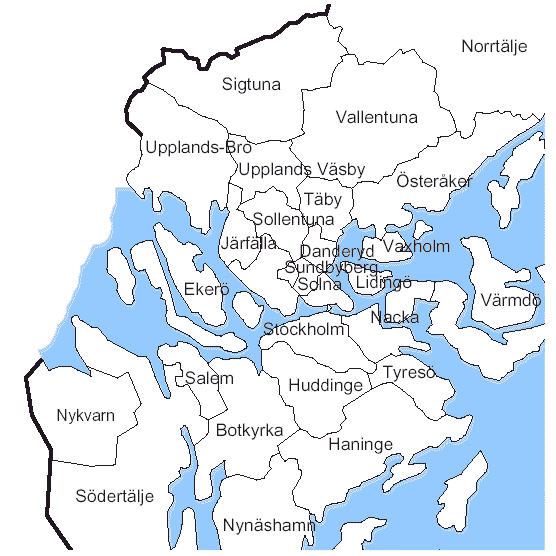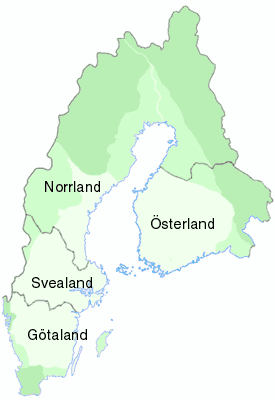|
Uppland
Uppland () is a historical province or ' on the eastern coast of Sweden, just north of Stockholm, the capital. It borders Södermanland, Västmanland and Gästrikland. It is also bounded by lake Mälaren and the Baltic Sea. On the small uninhabited island of Märket in the Baltic, Uppland has a very short and unusually shaped land border with Åland, an autonomous province of Finland. The name literally means ''up land'', a name which is commonly encountered in especially older English literature as ''Upland''. Its Latinised form, which is occasionally used, is ''Uplandia''. Uppland is famous for having the highest concentration of runestones in the world, with as many as 1,196 inscriptions in stone left by the Vikings. Administration The traditional provinces of Sweden serve no administrative or political purposes, but are historical and cultural entities. The corresponding administrative county, or ', is Uppsala County, which occupies the larger part of the territory ... [...More Info...] [...Related Items...] OR: [Wikipedia] [Google] [Baidu] |
Stockholm County
Stockholm County ( sv, Stockholms län, link=no ) is a county or '' län'' (in Swedish) on the Baltic Sea coast of Sweden. It borders Uppsala County and Södermanland County. It also borders Mälaren and the Baltic Sea. The city of Stockholm is the capital of Sweden. Stockholm County is divided by the historic provinces of Uppland ( Roslagen) and Södermanland (Södertörn). More than one fifth of the Swedish population lives in the county. Stockholm County is also one of the statistical '' riksområden'' (national areas) according to NUTS:SE, Nomenclature of Territorial Units for Statistics within the EU. With more than two million inhabitants, Stockholm is the most densely populated county of Sweden. History Stockholm County was established in 1714. The City of Stockholm then constituted its own administrative entity under the Governor of Stockholm and was not part of Stockholm County. Though outside Stockholm County, the City of Stockholm was its seat. On 1 Jan ... [...More Info...] [...Related Items...] OR: [Wikipedia] [Google] [Baidu] |
Runestone
A runestone is typically a raised stone with a runic inscription, but the term can also be applied to inscriptions on boulders and on bedrock. The tradition began in the 4th century and lasted into the 12th century, but most of the runestones date from the late Viking Age. Most runestones are located in Scandinavia, but there are also scattered runestones in locations that were visited by Norsemen during the Viking Age. Runestones are often memorials to dead men. Runestones were usually brightly coloured when erected, though this is no longer evident as the colour has worn off. The vast majority of runestones are found in Sweden. History The tradition of raising stones that had runic inscriptions first appeared in the 4th and 5th century, in Norway and Sweden, and these early runestones were usually placed next to graves. The earliest Danish runestones appeared in the 8th and 9th centuries, and there are about 50 runestones from the Migration Period in Scandinavia. Most runeston ... [...More Info...] [...Related Items...] OR: [Wikipedia] [Google] [Baidu] |
HSwMS Uppland
Several ships of the Swedish Navy have been named HSwMS ''Uppland'', named after Uppland province: * , a ship of the line A ship of the line was a type of naval warship constructed during the Age of Sail from the 17th century to the mid-19th century. The ship of the line was designed for the naval tactic known as the line of battle, which depended on the two colu ... launched in 1689 * , a galley launched in 1748 * , a ship of the line launched in 1749 and lost in battle in 1790 * , a launched in 1945 and decommissioned in 1979 * , a launched in 1996 {{DEFAULTSORT:Uppland, HSwMS Swedish Navy ship names ... [...More Info...] [...Related Items...] OR: [Wikipedia] [Google] [Baidu] |
Provinces Of Sweden
The provinces of Sweden ( sv, Sveriges landskap) are historical, geographical and cultural regions. Sweden has 25 provinces; they have no administrative function (except for in some cases as sport districts), but remain historical legacies and a means of cultural identification as pertains, for example, to dialects and folklore. Several of them were subdivisions of Sweden until 1634, when they were replaced by the counties of Sweden (''län''). Some were conquered later on from Denmark–Norway. Others, like the provinces of Finland, were lost. Lapland is the only province acquired through colonization. In some cases, the administrative counties correspond almost exactly to the provinces, as is Blekinge to Blekinge County and Gotland, which is a province, county and a municipality. While not exactly corresponding with the province, Härjedalen Municipality is beside Gotland the only municipality named after a province. In other cases, the county borders do not correspond wi ... [...More Info...] [...Related Items...] OR: [Wikipedia] [Google] [Baidu] |
Uppsala County
Uppsala County ( sv, Uppsala län) is a county or '' län'' on the eastern coast of Sweden, whose capital is the city of Uppsala. It borders the counties of Dalarna, Stockholm, Södermanland, Västmanland, Gävleborg, and the Baltic Sea. Province ''For History, Geography and Culture see: Uppland'' The northern parts of the province of Uppland encompasses Uppsala County. Administration The main aim of the County Administrative Board is to fulfil the goals set in national politics by the Riksdag and the Government, to coordinate the interests of the county, promote its development, establish regional goals and safeguard the due process of law in the handling of each case. The County Administrative Board is a Government Agency headed by a Governor. See List of Uppsala Governors. Politics The County Council of Uppsala or ''Region Uppsala'' (previously ''Landstinget i Uppsala län''), which is appointed by the electorate of the county, is primarily responsible for ... [...More Info...] [...Related Items...] OR: [Wikipedia] [Google] [Baidu] |
Stockholm
Stockholm () is the Capital city, capital and List of urban areas in Sweden by population, most populous city of Sweden as well as the List of urban areas in the Nordic countries, largest urban area in the Nordic countries. Approximately 1 million people live in the Stockholm Municipality, municipality, with 1.6 million in the Stockholm urban area, urban area, and 2.4 million in the Metropolitan Stockholm, metropolitan area. The city stretches across fourteen islands where Mälaren, Lake Mälaren flows into the Baltic Sea. Outside the city to the east, and along the coast, is the island chain of the Stockholm archipelago. The area has been settled since the Stone Age, in the 6th millennium BC, and was founded as a city in 1252 by Swedish statesman Birger Jarl. The city serves as the county seat of Stockholm County. Stockholm is the cultural, media, political, and economic centre of Sweden. The Stockholm region alone accounts for over a third of the country's Gross d ... [...More Info...] [...Related Items...] OR: [Wikipedia] [Google] [Baidu] |
Uppländska Dialect
Uppländska is a variety of Svealand Swedish spoken in Uppland Uppland () is a historical province or ' on the eastern coast of Sweden, just north of Stockholm, the capital. It borders Södermanland, Västmanland and Gästrikland. It is also bounded by lake Mälaren and the Baltic Sea. On the small un .... Usage has declined in recent decades, but restoration attempts have been made by linguistic societies. It is primarily spoken in Uppland, Stockholm and in Åland. References Uppland Swedish language Swedish dialects {{sweden-stub ... [...More Info...] [...Related Items...] OR: [Wikipedia] [Google] [Baidu] |
Södermanland
Södermanland ( or ), locally Sörmland, sometimes referred to under its Latin form ''Sudermannia'' or ''Sudermania'', is a historical province or ''landskap'' on the south eastern coast of Sweden. It borders Östergötland, Närke, Västmanland and Uppland. It is also bounded by lake Mälaren and the Baltic Sea. Södermanland means "(The) Land of the Southern Men", where the "southern men" (''södermännen'') were the people living south of Uppland. Administration The traditional provinces of Sweden serve no administrative or political purposes, but are historical and cultural entities. There is a corresponding administrative Södermanland County. However, the bulk of the population is within Stockholm County. Heraldry The coat of arms was granted in 1560. The arms is represented with a ducal coronet. Blazon: "Or, a Griffin rampant Sable beaked, langued, membered and armed Gules." The same CoA was granted for the county in 1940. Geography Södermanland is situ ... [...More Info...] [...Related Items...] OR: [Wikipedia] [Google] [Baidu] |
Svealand
Svealand (), or Swealand, is the historical core region of Sweden. It is located in south central Sweden and is one of three historical lands of Sweden, bounded to the north by Norrland and to the south by Götaland. Deep forests, Tiveden, Tylöskog, and Kolmården, separated Svealand from Götaland. Historically, its inhabitants were called , from which is derived the English ' Swedes'. Svealand consists of the capital region Mälardalen in the east, Roslagen in the north-east, the former mining district Bergslagen in the center, and Dalarna and Värmland in the west. The older name of Sweden in Swedish, (modern spelling: ) Realm of the Swedes, "Swea Region", originally only referred to Svealand. Other forms are (Old Norse/ Icelandic ), and . As the domains of the Swedish kings grew, the name Svealand began to be used to separate the original territory from the new. Provinces Svealand is made up of the following six provinces: * Dalarna *Närke *Södermanland ... [...More Info...] [...Related Items...] OR: [Wikipedia] [Google] [Baidu] |
Mälaren
Mälaren ( , , or ), historically referred to as Lake Malar in English, is the third-largest freshwater lake in Sweden (after Vänern and Vättern). Its area is 1,140 km2 and its greatest depth is 64 m. Mälaren spans 120 kilometers from east to west. The lake drains, from south-west to north-east, into the Baltic Sea through its natural outlets Norrström and Söderström (as it flows around Stadsholmen island) and through the artificial Södertälje Canal and Hammarbyleden waterway. The easternmost bay of Mälaren, in central Stockholm, is called Riddarfjärden. The lake is located in Svealand and bounded by the provinces of Uppland, Södermanland and Västmanland. The two largest islands in Mälaren are Selaön (91 km2) and Svartsjölandet (79 km2). Mälaren is low-lying and mostly relatively shallow. Being a quite narrow and shallow lake, Mälaren has bridge crossings between Eskilstuna and Västerås with two crossings on the western end at Kvi ... [...More Info...] [...Related Items...] OR: [Wikipedia] [Google] [Baidu] |
Västmanland
Västmanland ( or ), is a historical Swedish province, or ''landskap'', in middle Sweden. It borders Södermanland, Närke, Värmland, Dalarna and Uppland. Västmanland means "(The) Land of the Western Men", where the "western men" (''västermännen'') were the people living west of Uppland, the core province of early Sweden. Administration The traditional provinces of Sweden serve no administrative or political purposes (except sometimes as sport districts), but are historical and cultural entities. In the case of Västmanland the corresponding administrative county, Västmanland County, constitutes the eastern part of the province. The western part is in Örebro County where the municipalities of Hällefors, Lindesberg, Ljusnarsberg and Nora are located. Heraldry The coat of arms was granted in 1560. At the time it featured one fire mountain, to represent the mine of Sala Municipality. Soon, their numbers were increased to three, to also symbolize the Lindesberg ... [...More Info...] [...Related Items...] OR: [Wikipedia] [Google] [Baidu] |

.png)



.jpg)
